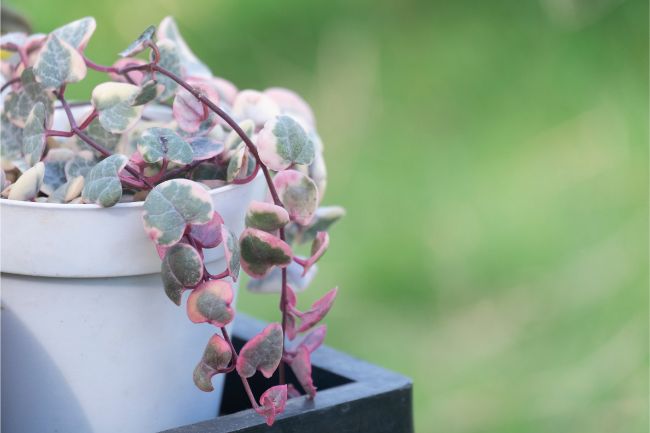Are you looking for a beautiful, unique, and easy to care for houseplant? The String of Hearts plant (Ceropegia woodii) is a delightful hanging plant to add to your home, with heart-shaped leaves trailing from thin, wiry vines and bearing a sprinkle of unique, pinkish flowers. This sweet plant goes by many names:
- Rosary Vine
- String of Hearts
- Chain of Hearts
- Sweetheart Vine
- Hearts Enmeshed (because the vines tangle easily)
- Ceropegia woodii
How to care for a string of hearts plant: Ceropegia woodii is a beautiful, trailing plant that needs very little effort to thrive. Provide bright, indirect light, water infrequently once the potting medium is dry, plant in well-draining soil, and fertilize every two weeks through the growing season to keep this drought-tolerant, tropical plant happy.
Keep reading to find out more about this unique plant, how to care for your String of Hearts, and how to propagate it.
Summary Of String Of Hearts Plant Care (Ceropegia Woodii)
- Scientific Name: Ceropegia woodii
- Common Name: String of Hearts plant, Rosary Vine, Chain of Hearts, Sweetheart Vine, Hearts enmeshed.
- Origin: South Africa, Swaziland and Zimbabwe.
- Light Requirements: Bright, indirect light.
- Watering: Only water once the potting medium is dry.
- Soil: Cactus or succulent mix. Alternatively, a good potting mix with plenty of added coarse sand or perlite.
- Temperature: 70-85°F (21-29°C). Will struggle below 60°F (15°C).
- Fertilizer: Balanced, water-soluble fertilizer applied every two weeks through the growing season. I use this one.
- Humidity: Low to medium humidity is fine.
- Flowering: Small bulbous flowers are produced when good conditions are provided. Flowers tend to blend in with the leaves.
- Pruning: Only necessary to control length of the vines
- Propagation: Tubers, which grow along the stems are easily rooted while attached to the parent plant. Stem cuttings can also be taken.
- Re-Potting: Rarely need repotting. Enjoy being root bound.
- Diseases and Pests: Generally hardy. Will develop root rot if overwatered. Can be prone to mealybugs.
- Toxicity: Non-toxic.
- Where To Buy: Buy a String Of Hearts Plant online at Etsy (I buy most of my houseplants from Etsy).
Characteristics
The String of Hearts is known for its wispy, trailing vines graced with variegated green and silver heart-shaped leaves. These pretty leaves usually grow as a deep green hue trimmed in little bits of silvery white.
The fleshy leaves generally have a pinkish underside with pink or even purple stems. New growth may appear tinged with pink, and its lovely Chinese lantern- shaped flowers offer up a pop of magenta color.
These pretty little vines are wiry and can grow two to three feet in length when grown as a houseplant. Small tubers, that look like bead-shaped bulbs, grow sporadically along the vines.
These little tubers can be planted to grow new String of Hearts plants. The String of Hearts is not a true succulent, but it is able to store plenty of water in its thick, fleshy leaves. It originates in Africa and likes heat and dry soil.
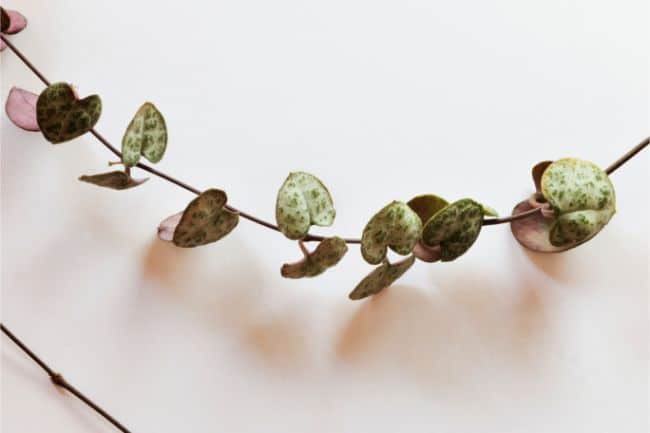
String Of Hearts Plant Light Requirements
The String of Hearts plant prefers to have some bright sun throughout the day, but it will do fine in bright, indirect light, as well. When grown in direct sunlight, the plant’s leaves will be dark green with variegated silver markings. In indirect light, the leaves will be a lighter green with softer variegated markings.
Your String of Hearts should do just fine in a low light situation, if needed, but the leaves will be a pale green with no variegation. The loss of variegation is probably permanent and the variegation will not return even if the plant is moved to better light.
How To Water String Of Hearts Plant
The meanest thing you can do to a String of Hearts plant is to overwater it. Your plant is far more likely to die from overwatering than it is from underwatering. Just give this drought-tolerant semi-succulent a good drink when the soil completely dries out, and then don’t water it again until the soil is dry again.
During the winter months, let the plant rest by watering it a little bit less. It might seem a little droopier during the winter, but don’t be tempted to compensate with extra water. This happens when the plant goes into a semi-dormant state and prepares for new growth to start in the spring.
Learn how to tell when your houseplants need water by reading my article which shares some handy tips to make sure you don’t overwater or underwater your plants.
Soil
Sometimes the String of Hearts Plant is called a semi-succulent because it stores a lot of moisture in its fleshy leaves. Because of this, it does not enjoy having “wet feet.” In other words, it does not like to sit in wet soil. Be sure to use a soil mix that drains well and dries out completely in between waterings to avoid damaging your sweetheart vine.
The University of Wisconsin-Madison Master Gardener Program recommends a pre-mixed cactus soil or any well-draining potting soil mixed with a good amount of sand or perlite.
A more complicated mix recommended by Joyusgarden.com is to use equal parts of coco coir, succulent & cactus mix, and a combination of orchid bark and charcoal. They also incorporate compost and worm castings.
Certainly, this rich mix would help your String of Hearts grow quite well, however, this plant is pretty hardy and should be fine in any type of well-draining soil with or without the worm castings.
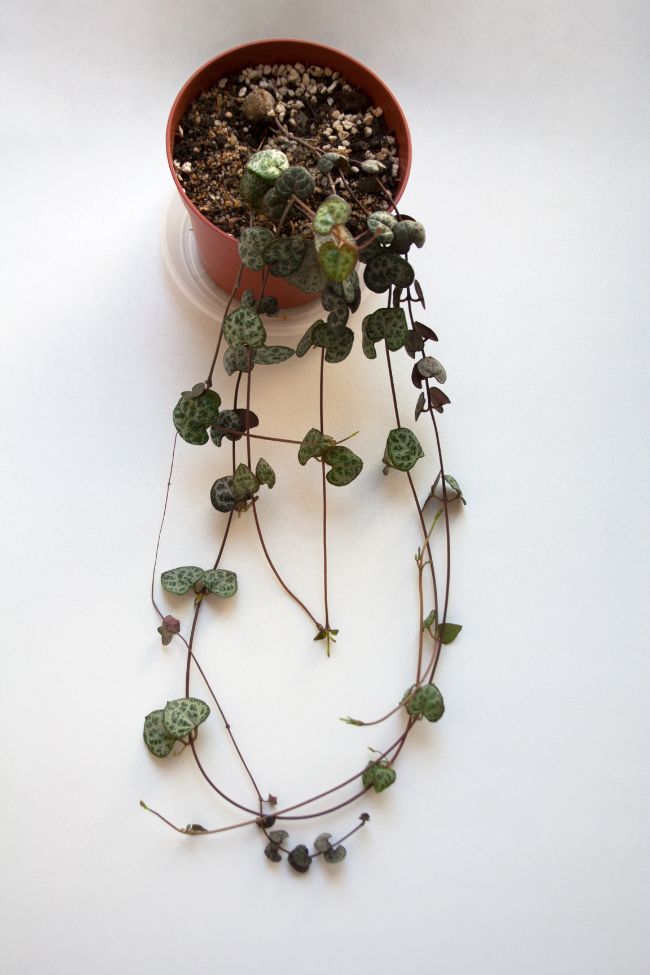
Temperature
The String of Hearts is a tropical plant, native to South Africa. Because of this, you’ll want to keep yours above 60°F (16°C). Ideally, it should be kept between 70-85°F (21-29°C). Think about it this way, if you are comfortable in a t-shirt, then your String of Hearts plant probably is comfortable, too.
This plant definitely can be grown outside in tropical climates. Even in more temperate areas, you can move yours outside for the summer. But you’ll need to acclimate your plant to the outdoors slowly so it doesn’t go into shock or get sunburned.
Move it outside for one hour per day, gradually increasing the amount of time outside over the course of a couple of days so it can adjust to being outdoors. Make sure you bring it back inside before the cooler weather hits, again acclimating the plant to the indoors a little bit at a time.
Some folks have reported being able to keep their String of Hearts Plants outside even when the temperature gets down into the low thirties. This is certainly possible with a healthy and well-adjusted plant, but it is risky to expose any tropical plant to such temperature extremes and you take the chance of losing the plant.
How To Fertilize Your String Of Hearts Plant
Fertilizer will help your String of Hearts grow longer vines and be more healthy and resistant to pests.
Ceropegia woodii has two seasons. The growing season runs from spring until about the middle of summer, and the semi-dormant season from autumn through winter. You only want to fertilize the String of Hearts during its growing season.
The easiest way to fertilize your String of Hearts is to use a balanced, water soluble or liquid fertilizer, and follow the manufacturer’s directions. Some growers prefer to use a diluted fertilizer at every watering so they do not have to remember when they last fertilized the plant. Either method should work equally well. This is the fertilizer I use for my String Of Hearts plant.
In mid-summer, stop fertilizing your String of Hearts. The plant will need time to slow down and go into its semi-dormant stage for fall and winter.
Humidity
Like many succulents, the String of Hearts does not require a lot of humidity to thrive. Your average, indoor humidity should be just fine because this plant prefers low humidity. You may not need to water the plant as often in a very humid environment.
Flowering
One of the characteristics of the String of Hearts plant is its unique flowers. The small flowers of the String of Hearts grow along the vines, easily blending in with the leaves. These small blossoms are shaped like small vases or lanterns, ranging in color from purple to burgundy.
They have a bulbous shape at the base of the flower, a long cylinder, and the plant is topped with a pretty ‘tent’ of petals that are attached at the top. String of Hearts plants usually flower in mid-summer and fall, but blooms can appear at any time.
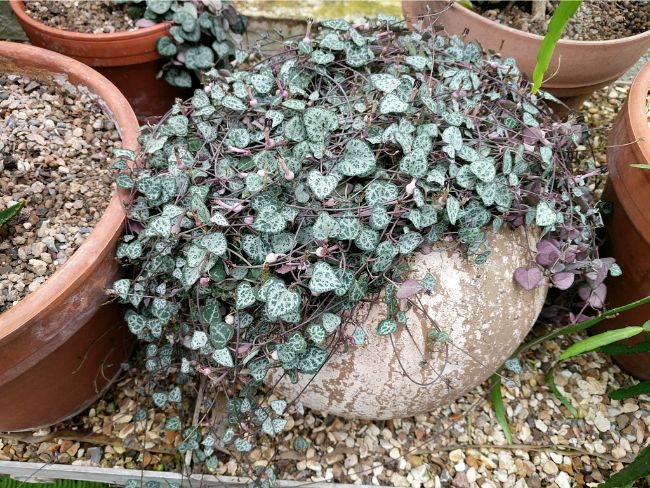
Pruning
The String of Hearts is a wispy plant, and grown as a houseplant, vines typically only reach around two feet long. In its natural habitat, String of Hearts plants can grow as much as twelve feet long.
You do not need to prune your String of Hearts plant. However, if the vines are too long for your taste, look too leggy, or you want to propagate some cuttings, then you can freely prune your plant. Otherwise, it’s probably just fine without pruning unless there are parts of the plant that are dying or rotting.
Pruning is easy. Simply snip off the vine with a pair of scissors or shears where you would like it to end. This plant is hardy enough to withstand a pretty harsh pruning, so don’t worry too much about being precise. You can use the clippings to start new plants either by putting the clippings in water or planting them directly in good soil.
How To Propagate Ceropegia Woodii
Propagating the String of Hearts is easy and almost always successful. There are two easy ways to propagate this little tropical plant. Small tubers grow along the vine that look like peas or beads. You can propagate the String of Hearts by planting these small beads, or by taking cuttings.
The best way to propagate the String of Hearts from tubers is to plant the tubers while they are still attached to the mother plant. For example, set your pot with your String of Hearts into a shallow tray of succulent soil mix. Arrange the vines so that the tubers lay on the soil in the tray.
Gently mist the soil so that it is damp, but not wet. Once the tubers take root and begin to grow new leaves, you can cut them from the mother plant by cutting the vine in between.
Repot them into their own pot. If this isn’t an option for you, you can stick the tubers or beads into the soil of the pot the plant is already in, or if necessary, you can cut off the tubers and replant them separately. Keep in mind, you’ll probably have better results if you allow the tubers to stay attached to the mother plant for a while after being planted.
It is also easy to propagate the String of Hearts from cuttings. Cut off several vines and poke the cut ends into their own pot of soil. Dampen the soil to encourage rooting, but make sure it isn’t too wet.
If this type of propagation isn’t for you, you can always snip off a couple of vines and put the ends in a bit of water. In time, they should naturally grow roots and then you can repot them into a succulent mix or other well-draining potting soil.
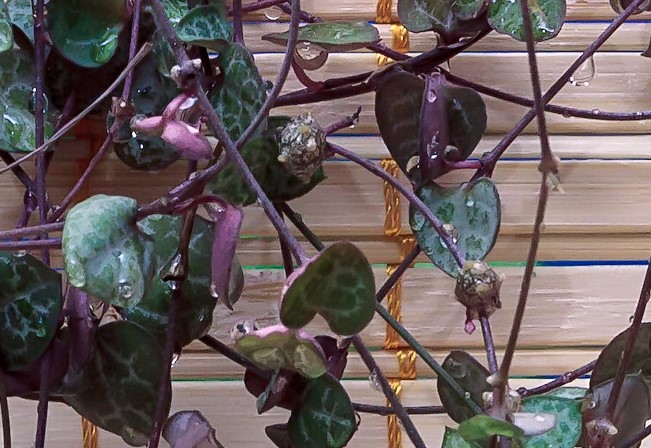
Tips For Planting
If you need to plant your String of Hearts, you need a smallish pot with a drainage hole or two. Do not overpot or use a pot that is too big for the plant because this species of plants prefers to have its roots slightly restricted.
Porous pots, such as terracotta, will help the soil dry out more quickly, while plastic containers tend to keep the moisture in. Choose a well-draining potting mix, such as a succulent soil or mix of potting soil and sand.
Fill the pot about half full with the potting mix, and then gently set the roots of the plant into the soil. Cover the roots gently with more soil and press the plant in lightly. Arrange the vines to trail down the side.
Any tubers that rest on the soil will turn into new plants over time. Give the plant a deep and thorough watering, but do not water it again until the soil has completely dried out.
Re-Potting
The String of Hearts enjoys being a bit rootbound, so there is no rush to repot the plant and you won’t need to do it often, if at all. The best time to repot this plant is in the spring, when the new growth begins to show or slightly before.
Use a pot with drainage holes to help promote good drainage so the soil can dry out completely. Prepare your soil mix, such as a succulent mix as mentioned above. Dampen the soil, then put it in your pot.
Lay your string of hearts on its side, and gently slide it out of its current pot. If you have multiple plants in one pot, this would be a good time to split them into multiple pots. Gently place the roots into the new pot, and lightly press the soil around the roots.Wait for the soil to dry out completely before watering.
Varieties
There are many different varieties of ceropegia, including String of Hearts and Turtles on a String. Other related plants include necklace flower, wine-glass vine, and bushman’s pipevine. Surprisingly, these widely varying plants are related to the milkweed species.
However, there are very few actual cultivars of String of Hearts. Variations within ceropegia woodii are often due to the presence of bright or poor light, causing a variance in the color and variegations in the leaves.
Diseases And Pests
The String of Hearts is a pretty hardy plant, and typically only has two main issues to worry about. The number one problem with string of hearts plants is getting over-watered, which causes the plant to rot. You can easily avoid this by being careful not to overwater and allowing the soil to completely dry out between watering. The second problem is a pest – the mealybug.
Mealybugs are small pinkish bugs that hide in a white, cottony webbing. They feed on the plants and can weaken and kill them. You can wash them off with water or dip a cotton swab in alcohol and wipe them off. Mealybugs are a common problem for most house plants.
Read all you need to know about getting rid of houseplant bugs using natural methods in this article.
Is String Of Hearts Plant Poisonous?
Ceropegia woodii is on the California Poison Control System non-toxic list for people, and the plant does not appear on the ASPCA’s toxic list for cats or dogs. Therefore, this plant is generally regarded as safe.
However, allergic reactions could still be a possibility in sensitive individuals and the little tubers could pose a choking hazard for small children. Also, just because a plant is generally regarded as safe, (GRAS), does not mean that it won’t cause vomiting and upset stomach.
Common Problems And Questions
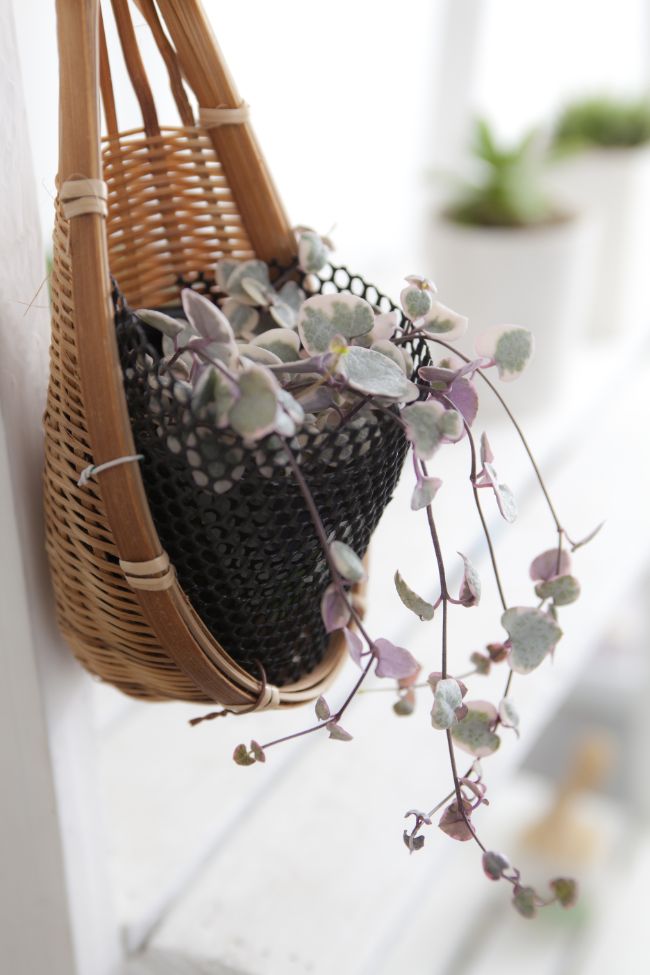
Overwatering
Overwatering is the number one cause of death in String of Hearts plants. The leaves may turn yellow, droop, and eventually the plant will rot. For best results, err on the side of underwatering rather than overwatering and allow the soil to dry out completely before watering again. Also, the plant may look slightly droopy when it goes into a semi-dormant state. This does not mean the plant needs more water.
Is Pruning Necessary?
No, you don’t need to prune your String of Hearts. However, you may want to control its length, cut off any dead leaves, or remove leggy vines. You can use any clippings to start new plants if you wish.
Troubleshooting String of Hearts Plant Pests and Problems
- Yellow, dropping leaves and a dying plant may be a sign of rot and overwatering.
- White, cottony webs on the plant may be a sign of mealybugs.
- Pale leaves are a sign the plant isn’t getting enough light. Move it to a brighter spot in your home with more natural light.
- Soft tubers are a sign that the plant is being overwatered and the roots are rotting and unable to spread moisture to the rest of the plant.
- Scorched leaves can mean the plant is getting too much direct sunlight, try moving your plant to a slightly shadier location.
Display Tips for Ceropegia Woodii
- Plant your String of Hearts in a hanging pot or basket and hang it in a window for a pretty display while it still gets plenty of light.
- Set your pot on a small plant stand so the vines can trail down on all sides, showing off its heart-shaped leaves and delicate flowers.
- Place your Rosary Vine in a pretty bowl and set it on your piano, a shelf, or any sunny spot where the delicate vines can be admired.
- Hang your plant in the dappled shade of a tree outside for the summer where it can get some bright light without being scorched by the sun.
With some basic care, the String of Hearts plant is easy to care for and beautiful to admire. Bright light, well-draining soil, a warm home, and just a little water will help your String of Hearts to thrive and grow.

